笨狼发牢骚
发发牢骚,解解闷,消消愁《皮尤研究中心》(Pew Research Center)最近按美国人口调查局的数据推测美国举足轻重的婴儿潮一代已经让位给新的一代,中文叫“Y世代”(Gen Y,即“Generation Y”,百度百科,18-34岁)。但在美国大家更常将“Generation Y”成为“Millennials”。
中文里“千年”不是个常用的单位(不如“百年”),有叫“千纪”,“千禧”,“千禧年”的,百度说“千禧年又名千福年,其概念源于基督教教义”,咱入乡随俗,与其叫“Y世代”,不如叫“千禧代”。
《皮尤研究中心》的分类:

这是另一个图示美国百年代构:
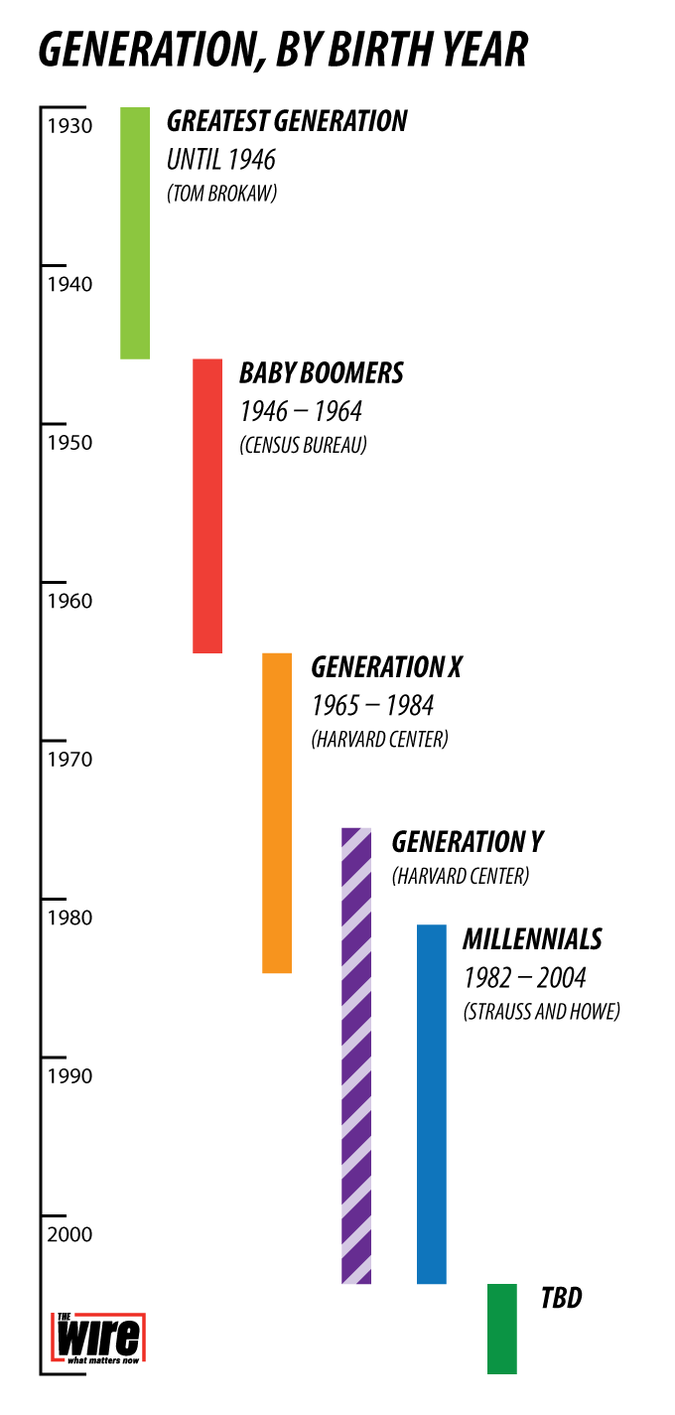
参见维基:Generation Z refers to the cohort of people born after the Millennial Generation
《皮尤研究中心》的定义:

较为详尽的解释,参见:
William SchroerGenerations X,Y, Z and the Others
这是《皮尤研究中心》的判断:
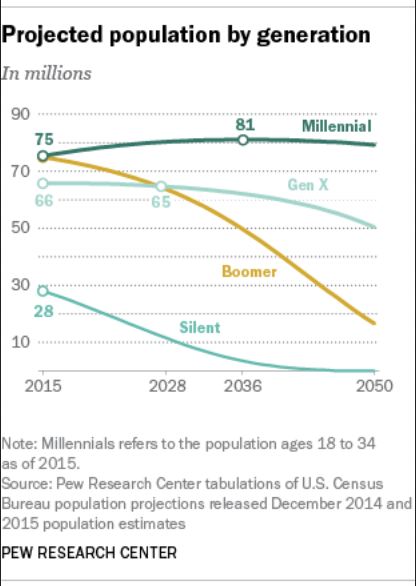
德勤(会计咨询公司Deloitte ,全称Deloitte Touche Tohmatsu Limited)用美国人口调查局的数据给美国青年人(20-34岁)人口结构过去20几年的图,如下:
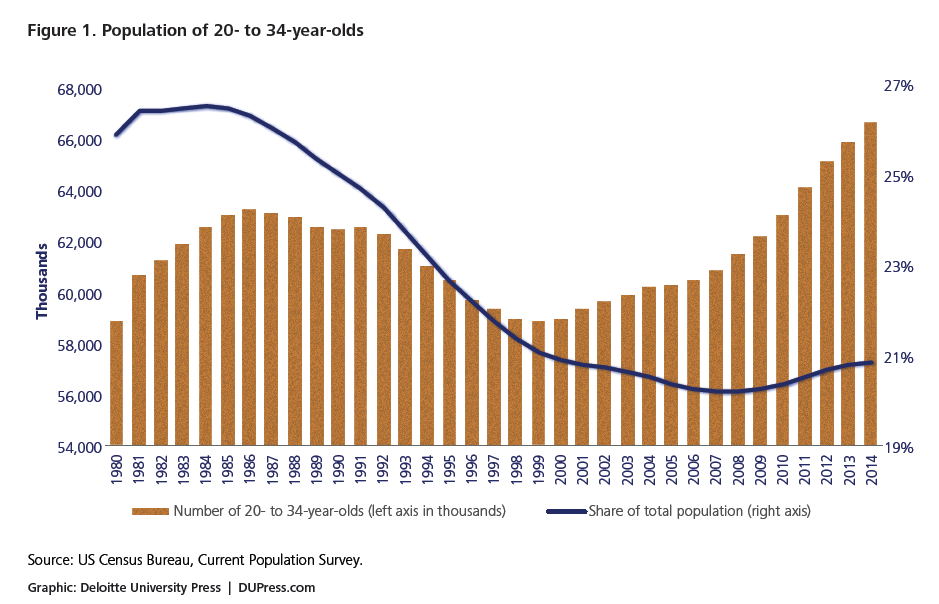
“千禧代”并不是苹果谷狗脸书那新时代新精神充满朝气希望无比的一代,你要是冷静想想,苹果谷狗脸书实际上是精英阶层,人数很少,不足以解决整代人的生计,德勤给出的两个特征充分说明了这一点:
(一)教育
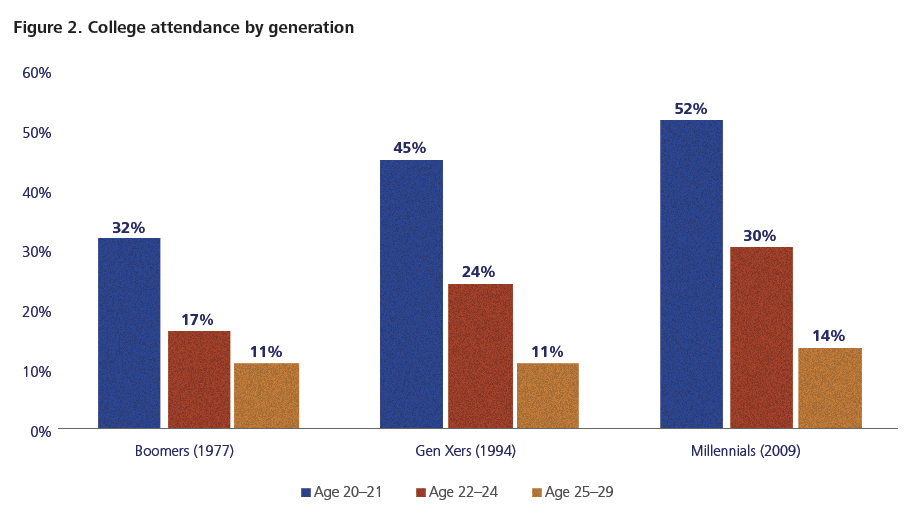
是的,教育程度高了不少
(二)收入
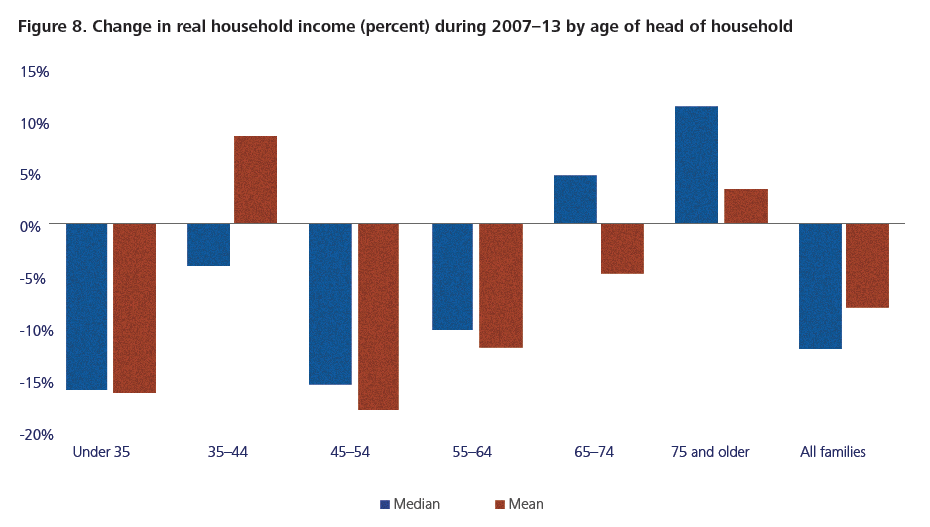
2007-2008解决大危机却是最受打击的一代之一,而且负债累累:

(由此可见为什么闲得死一呼“大学免费”而百应。)
然而“千禧代”却是充满乐观精神,大家也许最关心的两个方面:
宗教:
《皮尤研究中心》Q&A: Why Millennials are less religious than older Americans
《大众电视台PBS)Poll Finds Americans, Especially Millennials, Moving Away From Religion
“千禧代”不如老一辈那么信教、虔诚,基督教的狂热程度自然降低,在全球推广西方至高无上的的精神。
经济:
《大西洋月刊》Millennials' Political Views Don't Make Any Sense
《全国电台NPR》Generation Disappointed: Millennials Want More From Politics
《天天见兽性Daily Beast》Hey, GOP, Here’s Why Millennials Hate Us
政治解决被边缘化,生活越来越窘迫,没钱还得买个苹果机露露脸,过得挺艰难,故此整一代都有欧洲化的趋势,讲政府、福利、保障、公平,对美国历来“赢者通吃”(俗称“美国梦”【注1】)“一日升天”(俗称“instant gratification”)的美国精神是个反叛,会让美国变得日益“社会主义化”。那“放眼世界”的宏大目标,解决不了实实在在的衣食住行,解放“阿富汗伊拉克叙利亚难民”的灾难,保卫亚洲自由人民的利益,跟中国在南海干一仗嘛,就免了【注2】。
《华邮网文》
A majority of millennials now reject capitalism, poll shows
Millennials are increasingly rejecting voodoo economics
曾几何时?
也许“千禧代”标志着美国社会彻底的转变。
【注1】我把“美国梦”(American dream)说成“赢者通吃”,大逆不道。我想说的是,“美国梦”是真的,这是为什么全世界穷人,能来的,都涌到美国的原因。即使有钱人也把美国作为寄托之乡,问问中国的上层和高层领导就行了。只是世界太小,美国还是不够大,“得道升天”在美国“成功”的,微乎其微,一看统计,残酷极了。
其实是个“赢者通吃”。
【注2】美国精英不是这么想的。对精英来说,“胸怀全球,放眼世界”,其实是“征服全球,统治世界”,是美国人的职责,奥巴马所言“咱美国还是世界第一”是也。只是统治了世界,美国百姓还是分不到一羹肉,大家也难免没觉悟了。
【注3】“千禧代”对投资的态度:
![Millennials on Investing, Debt, and Banking [Chart]](http://2oqz471sa19h3vbwa53m33yj.wpengine.netdna-cdn.com/wp-content/uploads/2015/11/millennials-investing-debt-chart.jpg)
【附录】《纽约时报》收复制造业就业的海市蜃楼(参见:美国那日落黄昏的制造业岗位)被标榜为奥巴马最大经济成就的“泛太协议”(昵称踢屁屁,就是踢中国的屁屁)肯定不会给美国增加就业机会,制造业就跟没戏了,这,连最左的经济学家也坚信不疑,唯一说有的只有奥巴马一人。
The Mirage of a Return to Manufacturing Greatness
Eduardo Porter, ECONOMIC SCENE APRIL 26, 2016

Assembling televisions at Element Electronics in Winnsboro, S.C. Despite efforts to revive manufacturing in the United States, economists say the chances of a recovery are slim. Credit Chris Keane/Reuters
Half a century ago, harvesting California’s 2.2 million tons of tomatoes for ketchup required as many as 45,000 workers. In the 1960s, though, scientists and engineers at the University of California, Davis, developed an oblong tomato that lent itself to being machine-picked and an efficient mechanical harvester to do the job in one pass through a field.
The battle to save jobs was on.
How could a publicly funded university invest in research that cut farmworker jobs only to help large-scale growers? That was the question raised in a lawsuit filed by a farmworker advocacy group against U.C. Davis in 1979.
César Chavez’s United Farm Workers union made stopping mechanization its No. 1 legislative priority. In 1980, President Jimmy Carter’s agriculture secretary, Robert Bergland, declared that the federal government would no longer finance research that could lead to the “replacing of an adequate and willing work force with machines.”
These days, the battle to save American jobs has a different flavor. It echoes in Hillary Clinton’s promise “to win the global competition for manufacturing jobs and production.” It lives in Donald Trump’s call to break Nafta and impose a 45 percent tariff against Chinese imports, and in Bernie Sanders’s rallying cry against trade agreements.
Its outcome, however, will probably be similar. The freeze on research may have slowed the mechanization of California’s harvests, but by the year 2000, only 5,000 harvest workers were employed in California to pick and sort what was by then a 12-million-ton crop of tomatoes.
In America’s factories, jobs are inevitably disappearing, too. But despite the political rhetoric, the problem is not mainly globalization. Manufacturing jobs are on the decline in factories around the world.
“The observation is uncontroversial,” said Joseph Stiglitz, the Nobel-winning economist at Columbia University. “Global employment in manufacturing is going down because productivity increases are exceeding increases in demand for manufactured products by a significant amount.”
The consequences of this dynamic are often misunderstood, not least by politicians offering slogans to fix them.
No matter how high the tariffs Mr. Trump wants to raise to encircle the American economy, he will not be able to produce a manufacturing renaissance at home. Neither would changing tax rules to limit corporate flight from the United States, as Mrs. Clinton proposes.
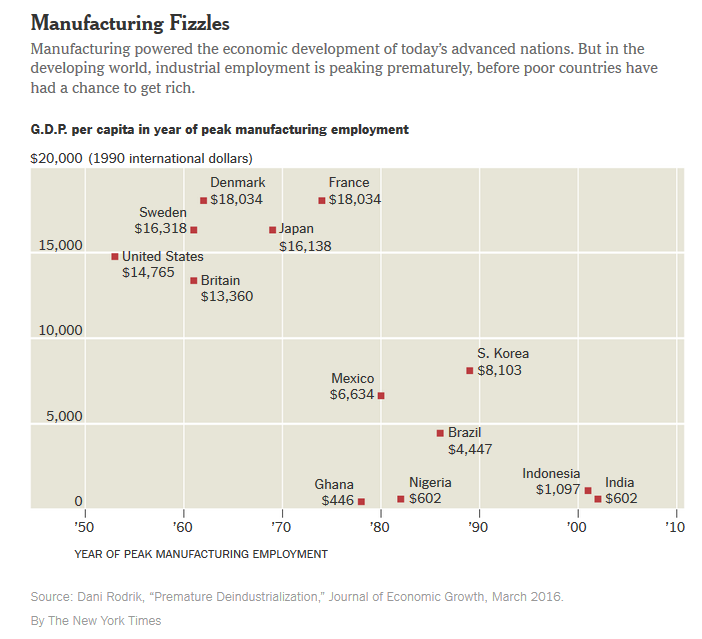
“The likelihood that we will get a manufacturing recovery is close to nil,” Professor Stiglitz said. “We are more likely to have a smaller share of a shrinking pie.”
Look at it this way: Over the course of the 20th century, farm employment in the United States dropped to 2 percent of the work force from 41 percent, even as output soared. Since 1950, manufacturing’s share has shrunk to 8.5 percent of nonfarm jobs, from 24 percent. It still has a ways to go.
The shrinking of manufacturing employment is global. In other words, strategies to restore manufacturing jobs in one country will amount to destroying them in another, in a worldwide zero-sum game.
The loss of such jobs has created plenty of problems in the United States. For the countless workers living in less developed reaches of the world, though, it adds up to a potential disaster.
Japan’s long stagnation can be read as a consequence of a decades-long development strategy that left the nation overly dependent on manufacturing. “They are focused on a dead-end business,” said Bruce Greenwald, an expert on investment strategy at Columbia Business School. “They are not eliminating hours of work in manufacturing fast enough to keep pace with the reduction in work needed.”
The richest countries today started deindustrializing when they were already well off and benefited from fairly skilled and productive work forces that could make the transition into well-paid service jobs, as increasingly affluent consumers devoted less of their incomes to physical goods and more to leisure, advanced health care and other services.
Poorer countries have more limited options. If the demise of manufacturing jobs in the United States forced many workers into low-paid retail jobs and the like, imagine the challenge in a country like India, where factory employment has already topped out, yet income per person is only one twenty-fifth of what it was in the United States at its peak.
“Developing countries are suffering premature deindustrialization,” said Dani Rodrik, a leading expert on the international economy who teaches at Harvard’s Kennedy School. “Both employment and output deindustrialization is setting in at much lower levels of income.”
This is even happening in a manufacturing behemoth like China — which appears to have maxed out the industrial export strategy at a much lower income level than its successful Asian predecessors, like Japan and Taiwan.

For poorer countries in Asia, Africa and Latin America, the decline of manufacturing as a bountiful source of jobs puts an end to the prime path to riches that the modern world has followed.
A Chinese worker paints ceramic Smurfs in a factory in Fujian Province. China appears to have reached the limits of its industrial export strategy. Credit Kevin Frayer/Getty Images
Manufacturing, Professor Rodrik points out, has unique advantages. For one thing, it can quickly employ lots of unskilled workers. “Setting up a factory to make toys puts you on a productivity escalator in a way that traditional agriculture and services didn’t do,” he said.
Moreover, production isn’t constrained by a small domestic market: Exports of goods can easily flow around the world, allowing industry room to grow and giving developing countries time to ride up the ladder of income, skills and sophistication.
The natural resources that dominate the exports of many poor countries don’t have these features. They employ few workers and offer little added value. They do not encourage acquiring skills, and they expose countries to violent swings in commodity prices.
High-end services such as finance and programming do pay well. But these aren’t the service sectors most poor countries build. A majority of service jobs in most poor countries are generally limited to housework, mom and pop retail and the like. Since these sectors offer little productivity growth and are generally isolated from foreign competition, they cannot pull a nation out of poverty.
The first large transition from agriculture to industry in the early 20th century — well lubricated by public spending on world wars — liberated workers from their chains far more effectively than Karl Marx’s revolution ever did.
The current transition, from manufacturing to services, is more problematic. In poor countries, Mr. Rodrik says, workers may have to pare back their aspirations of development. Who knows “how will political systems manage?” he asks.
In the United States, the political challenge is no less daunting. Low pay married to high profits in much of the service economy are contributing to a widening income chasm that is rending society in all sorts of ways. Used to the prosperity once delivered by manufacturing, American workers are rebelling against the changing tide.
Note to Mrs. Clinton, Mr. Sanders and Mr. Trump: A grab at the world’s manufacturing jobs is the wrong answer. Walls will damage prosperity, not enhance it. Promises to recapture industrial-era greatness ring hollow.
The United States, though, does have options: health care, education and clean energy, just to name a few. They present big economic and political challenges, of course — not least the enormous inefficiency of private American medicine and Republicans’ blanket opposition to more public spending.
Yet just as the federal government once provided a critical push to move the economy from its agricultural past into its industrial future, so, too, could it help build a postindustrial tomorrow.




